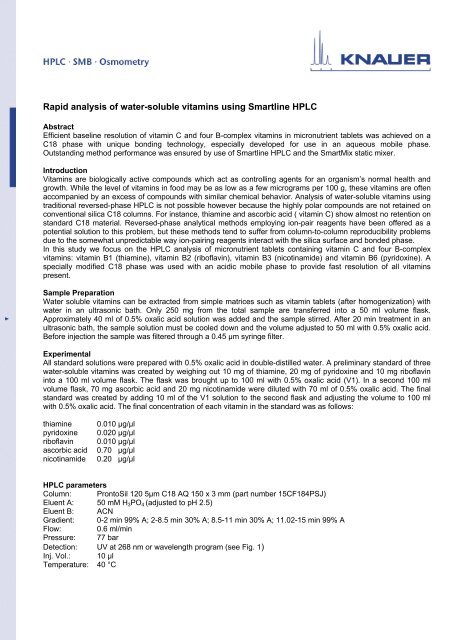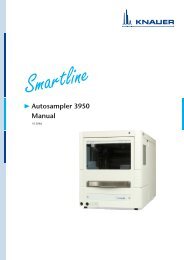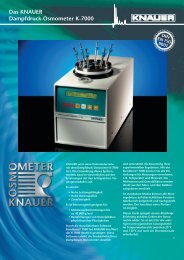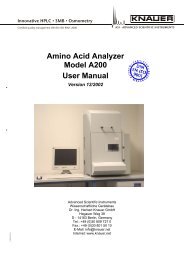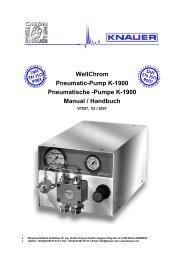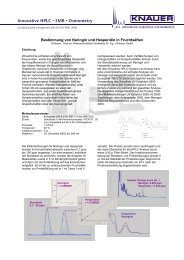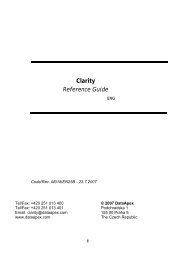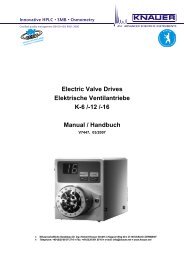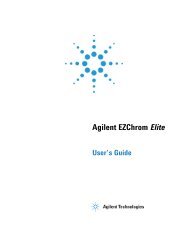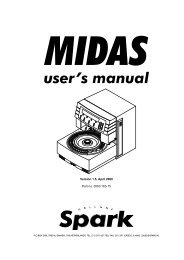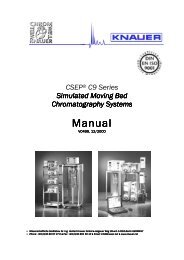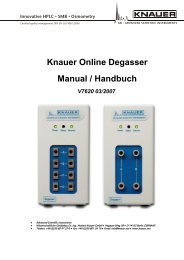Rapid analysis of water-soluble vitamins using Smartline HPLC
Rapid analysis of water-soluble vitamins using Smartline HPLC
Rapid analysis of water-soluble vitamins using Smartline HPLC
Create successful ePaper yourself
Turn your PDF publications into a flip-book with our unique Google optimized e-Paper software.
<strong>Rapid</strong> <strong>analysis</strong> <strong>of</strong> <strong>water</strong>-<strong>soluble</strong> <strong>vitamins</strong> <strong>using</strong> <strong>Smartline</strong> <strong>HPLC</strong><br />
Abstract<br />
Efficient baseline resolution <strong>of</strong> vitamin C and four B-complex <strong>vitamins</strong> in micronutrient tablets was achieved on a<br />
C18 phase with unique bonding technology, especially developed for use in an aqueous mobile phase.<br />
Outstanding method performance was ensured by use <strong>of</strong> <strong>Smartline</strong> <strong>HPLC</strong> and the SmartMix static mixer.<br />
Introduction<br />
Vitamins are biologically active compounds which act as controlling agents for an organism’s normal health and<br />
growth. While the level <strong>of</strong> <strong>vitamins</strong> in food may be as low as a few micrograms per 100 g, these <strong>vitamins</strong> are <strong>of</strong>ten<br />
accompanied by an excess <strong>of</strong> compounds with similar chemical behavior. Analysis <strong>of</strong> <strong>water</strong>-<strong>soluble</strong> <strong>vitamins</strong> <strong>using</strong><br />
traditional reversed-phase <strong>HPLC</strong> is not possible however because the highly polar compounds are not retained on<br />
conventional silica C18 columns. For instance, thiamine and ascorbic acid ( vitamin C) show almost no retention on<br />
standard C18 material. Reversed-phase analytical methods employing ion-pair reagents have been <strong>of</strong>fered as a<br />
potential solution to this problem, but these methods tend to suffer from column-to-column reproducibility problems<br />
due to the somewhat unpredictable way ion-pairing reagents interact with the silica surface and bonded phase.<br />
In this study we focus on the <strong>HPLC</strong> <strong>analysis</strong> <strong>of</strong> micronutrient tablets containing vitamin C and four B-complex<br />
<strong>vitamins</strong>: vitamin B1 (thiamine), vitamin B2 (rib<strong>of</strong>lavin), vitamin B3 (nicotinamide) and vitamin B6 (pyridoxine). A<br />
specially modified C18 phase was used with an acidic mobile phase to provide fast resolution <strong>of</strong> all <strong>vitamins</strong><br />
present.<br />
Sample Preparation<br />
Water <strong>soluble</strong> <strong>vitamins</strong> can be extracted from simple matrices such as vitamin tablets (after homogenization) with<br />
<strong>water</strong> in an ultrasonic bath. Only 250 mg from the total sample are transferred into a 50 ml volume flask.<br />
Approximately 40 ml <strong>of</strong> 0.5% oxalic acid solution was added and the sample stirred. After 20 min treatment in an<br />
ultrasonic bath, the sample solution must be cooled down and the volume adjusted to 50 ml with 0.5% oxalic acid.<br />
Before injection the sample was filtered through a 0.45 µm syringe filter.<br />
Experimental<br />
All standard solutions were prepared with 0.5% oxalic acid in double-distilled <strong>water</strong>. A preliminary standard <strong>of</strong> three<br />
<strong>water</strong>-<strong>soluble</strong> <strong>vitamins</strong> was created by weighing out 10 mg <strong>of</strong> thiamine, 20 mg <strong>of</strong> pyridoxine and 10 mg rib<strong>of</strong>lavin<br />
into a 100 ml volume flask. The flask was brought up to 100 ml with 0.5% oxalic acid (V1). In a second 100 ml<br />
volume flask, 70 mg ascorbic acid and 20 mg nicotinamide were diluted with 70 ml <strong>of</strong> 0.5% oxalic acid. The final<br />
standard was created by adding 10 ml <strong>of</strong> the V1 solution to the second flask and adjusting the volume to 100 ml<br />
with 0.5% oxalic acid. The final concentration <strong>of</strong> each vitamin in the standard was as follows:<br />
thiamine<br />
pyridoxine<br />
rib<strong>of</strong>lavin<br />
ascorbic acid<br />
nicotinamide<br />
0.010 µg/µl<br />
0.020 µg/µl<br />
0.010 µg/µl<br />
0.70 µg/µl<br />
0.20 µg/µl<br />
<strong>HPLC</strong> parameters<br />
Column: ProntoSil 120 5µm C18 AQ 150 x 3 mm (part number 15CF184PSJ)<br />
Eluent A: 50 mM H 3 PO 4 (adjusted to pH 2.5)<br />
Eluent B: ACN<br />
Gradient: 0-2 min 99% A; 2-8.5 min 30% A; 8.5-11 min 30% A; 11.02-15 min 99% A<br />
Flow: 0.6 ml/min<br />
Pressure: 77 bar<br />
Detection: UV at 268 nm or wavelength program (see Fig. 1)<br />
Inj. Vol.: 10 µl<br />
Temperature: 40 °C
Instrumentation<br />
KNAUER <strong>Smartline</strong> <strong>HPLC</strong> system equipped with Autosampler 3900, Pump 1000 with 10 ml pump head, SmartMix<br />
static mixer, Manager 5000 with low pressure gradient and degasser modules, Column Oven 4000 and UV<br />
Detector 2600 with analytical flow cell.<br />
Results<br />
Since each vitamin has a slightly different optimal absorption wavelength (Fig. 1), a wavelength switching program<br />
was used to increase the sensitivity <strong>of</strong> quantification for each vitamin. Figure 2 depicts the chromatogram obtained<br />
for the micronutrient tablet sample. Analysis results are listed in Table 1.<br />
- ascorbic acid<br />
- nicotinamide<br />
- pyridoxine<br />
- rib<strong>of</strong>lavin<br />
- thiamine<br />
200<br />
|<br />
220<br />
|<br />
240| 260| | | | |<br />
210 230 250 270 280 290 300 310 320 330 340<br />
nm<br />
200 220 240 260 280 300 320 340 nm<br />
Fig. 1 Wavelength spectrum <strong>of</strong> 5 <strong>water</strong>-<strong>soluble</strong> <strong>vitamins</strong>.<br />
mAU<br />
2000<br />
1800<br />
1600<br />
1400<br />
1200<br />
1000<br />
800<br />
600<br />
400<br />
200<br />
oxalic acid, λ = 246 nm<br />
thiamine (vitamin B1), λ = 246 nm<br />
ascorbic acid (vitamin C), λ =2 40 nm<br />
nicotinamide (vitamin B3), λ = 260 nm<br />
pyridoxine (vitamin B6), λ = 290 nm<br />
rib<strong>of</strong>lavin (vitamin B2), λ = 267 nm<br />
0<br />
-200<br />
Fig. 2<br />
0,0 0,5 1,0 1,5 2,0 2,5 3,0 3,5 4,0 4,5 5,0 5,5 6,0 6,5 7,0 7,5<br />
Minutes<br />
Separation <strong>of</strong> five <strong>vitamins</strong> in a micronutrient tablet.<br />
2/3
Table 1<br />
Peak # Substance t R [min] Area Asymmetry ESTD<br />
[mg/core]<br />
1 Oxalic acid 1.328 2877790 1.18 -<br />
2 Thiamine (vitamin B1) 1.742 509181 2.04 1.26<br />
3 Ascorbic acid (vitamin C) 2.185 12239574 1.05 63.5<br />
4 Nicotinamide (vitamin B3) 2.877 4208215 1.00 16.2<br />
5 Pyridoxine (vitamin B6) 4.538 695962 0.90 1.71<br />
6 Rib<strong>of</strong>lavin (vitamin B2) 6.436 395154 1.25 1.26<br />
<strong>HPLC</strong> method performance<br />
Limit <strong>of</strong> detection (S/N = 3)<br />
Substance<br />
LOD<br />
[ng]<br />
Oxalic acid -<br />
Thiamine (vitamin B1) 17.5<br />
Ascorbic acid (vitamin C) 59<br />
Nicotinamide (vitamin B3) 20<br />
Pyridoxine (vitamin B6) 8<br />
Rib<strong>of</strong>lavin (vitamin B2) 2<br />
Repeatability <strong>of</strong><br />
Retention time over 10 runs:<br />
Areas over 10 runs<br />
< 0.2 % RSD<br />
< 3 % RSD<br />
Conclusion<br />
A fast separation <strong>of</strong> five <strong>vitamins</strong> with good peak symmetry is easily accomplished by reversed-phase <strong>HPLC</strong> <strong>using</strong><br />
the ProntoSil C18 AQ column and <strong>Smartline</strong> <strong>HPLC</strong>. Thanks to the SmartMix static mixer, gradient mixing was<br />
performed efficiently while minimizing baseline noise, making lower limits <strong>of</strong> detection and < 0.2 % RSD in retention<br />
times possible.<br />
To request more information on this topic or products involved here, please visit www.knauer.net/worldwide to<br />
find your local distributor, or write to info@knauer.net.<br />
Wissenschaftliche Gerätebau<br />
Dr. Ing. Herbert Knauer GmbH<br />
Hegauer Weg 38<br />
D-14163 Berlin, Germany<br />
Phone: +49-(0)30-809727-0<br />
Fax: +49-(0)30-8015010<br />
E-Mail: info@knauer.net<br />
Internet: www.knauer.net<br />
3/3


